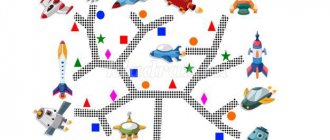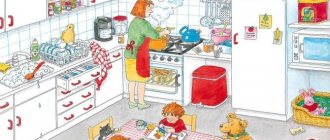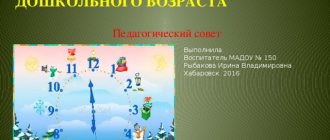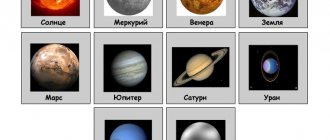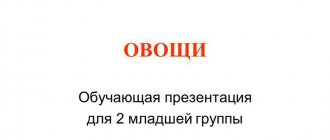Presentation “Journey into Space”
- May 22, 2012
Competition "Presentation Master - 2012"
Nomination "Presentation in the pedagogical process in preschool educational institutions"
To digest knowledge well, you need to absorb it with appetite.
A. France
The use of various methods of transmitting information in the classroom, including information and multimedia technologies, makes it possible to effectively carry out work on the cognitive development of preschool children and to take a creative approach to the process of solving the problems of teaching and upbringing.
The presentation “Journey into Space” was developed as part of a project for senior preschool age on the cognitive development of children “Me and the world around me,” of which I am the author. It was used in a travel lesson (educational area “Cognition, familiarization with the world around us”) (Appendix 2 Lesson notes) which made it possible to solve a number of problems:
- expanding children's knowledge about space, space objects, acquaintance with the history of space exploration, with the fact that the first cosmonaut in the world was a citizen of our country, Yuri Alekseevich Gagarin, who made his flight on April 12, 1967;
- development of memory, attention, imagination, fantasy, aesthetic perception;
- nurturing patriotic feelings, cognitive interest, and the desire to display one’s impressions in drawings.
This presentation made it possible to focus children’s attention on the space objects being studied and to interest them. The result of the lesson using this presentation was the cognitive and creative activity of the students. On the children's initiative, involving parents, we organized a role-playing game for children "Space Travelers" in the group, created a corner "Space", prepared a folder of consultations for parents, and held an exhibition of children's creative works on this topic.
This material can be used as a basis for classes, quizzes and other events on space topics (senior preschool and primary school age). By rearranging slides, adding and removing effects, video and audio fragments, the presentation is customized to the tasks of each specific teacher.
Application: Presentation.
Author: Polina Vladimirovna Sinenko, teacher of the 1st qualification category of MBDOU No. 81 Child Development Center - Kindergarten "Little Little Humpbacked Horse", Norilsk. In my teaching activities, I pay special attention to the cognitive development of children and broadening their horizons.
Robots Education Creativity
Details Published: 01/29/2020 14:26
Who hasn’t dreamed of feeling like a designer or test cosmonaut as a child? Build a real spaceship and launch it into space? Children will conquer space distances later, but for now we bring to your attention a summary of the constructive model activity “Spaceship” in the preparatory group, which was developed and sent by Albina Rifovna Salimova , additional education teacher at MBDOU “DS “Zvezdochka” (Yamalo-Nenets Autonomous Okrug, Novy Urengoy) .
Abstract of constructive model activity “Spaceship”
Goal : formation of ideas and expansion of acquired knowledge and constructive skills, the ability to create a plan and implement it; strengthen constructive skills.
Tasks
Educational:
- Learn to think about the design of a future building, imagine its general design solution, relate it to the available building material and the possibilities of its spatial arrangement.
Educational:
- To develop visual attention, imagination, thinking, and fine motor skills using constructive material;
- Expand vocabulary (spaceship, design bureau);
- Strengthen the ability to work in a team, use a common set of parts.
Educational:
- Cultivate neatness, curiosity, and the desire to play with buildings;
- Develop the ability to work in a group, negotiate, and take into account the opinion of a partner.
Equipment : interactive whiteboard, easel, video clip, projector, LEGO Education constructor for a subgroup, diagrams for assembling spaceships, demonstration material on the topic “Space”.
Progress of the lesson
- Hello, guys (children's answers)
- Today I have prepared an unusual task for you, a rebus task.
I suggest you guess from small fragments what is depicted on the easel. Want to know what's shown there? (children's answers). You will name the card number, and I will remove this card and so on until you guess what is shown there (an image of the Earth).
- What planets do you know? (children's answers)
—Where are the planets? (in space)
—Who are astronauts? (children's answers)
—What do they use to fly into space? (children's answers)
— What else can you call a rocket? (spaceship).
— What else can you tell about space? (children's answers).
- Who will remember the name of the first cosmonaut who flew into space? (Yuri Alekseyevich Gagarin).
- Who can tell me what a cosmodrome is? (a specially prepared area with structures and equipment located on it for assembling, testing and launching launch vehicles with spacecraft).
— Guys, what do you think, who and where are the spaceships? (children's answers).
The presentation is shown.
- In the design bureau. Design engineers work there; they develop various models of spaceships and spacecraft for flight to other planets of our solar system. First, one designer develops an idea, then, if his development is interesting, an entire design bureau takes on it, and then a model is made. A model is a model of the future ship. And only then assemblers join the designers: fitters, electricians, welders.
Design engineers are very smart, erudite people. They can read diagrams. The most famous space designer in Russia was Sergei Pavlovich Korolev - a scientist and designer. Developer of the first manned spacecraft. It was on the Vostok ship, which Korolev designed, that Yuri Gagarin flew into space.
A beep sounds.
-What kind of signal is this? (children's answers)
It is turned on in the event of an emergency. This signal is broadcast through special detectors installed in all areas of the city and is the sound of a single-tone siren (air raid signal). After this, a pre-recorded message about the current situation begins to be broadcast on radio and television channels; if necessary, instructions are given on the actions that citizens should take at the current moment.
- So let's see what happened?
Demonstration of a video clip.
— Guys, how can we help the astronauts? (children's answers)
“I think that we already know enough about space and can build a spaceship ourselves.”
- Let's split into pairs and go to the design bureau and transform into design engineers and start assembling.
— Before hard work, I suggest you warm up a little.
Who, tell me, can, children, repeat these movements? I'll raise my hands up. I can do this too. I'll move left and right. I can do that too. And like a bird I will fly. I can do this too. I'll turn my head. I can do this too. And then I’ll sit down and stand up. I can do this too. And I won’t get tired at all. I can do this too. I'll jump around a little. I can do this too. And we will go to the bureau. I can do this too. If necessary, I'll run. I can do this too. Necessary? I'll help a friend! I can do anything, I can do anything!
- And so let's get started! To do this, each of you has a set of “LEGO” parts from which you will construct a model of your spaceship.
— Guys, we have very little time, since the astronauts are waiting for help as soon as possible. Let's try to get it done in 10 minutes. And in order to know when to complete construction, we will set an alarm clock. As soon as it rings for the first time, it will mean that it is time to finish the work, and when it rings for the second time, we finish and get ready to fly.
(Children complete the task. Children who find it difficult to build according to their own plans are offered assistant diagrams to choose from so that, based on them, they can build their own model. Be sure to mention that the diagrams are assistants).
— Construction is finished, the moment of testing has come. Place astronauts in your spaceships.
The projector with imitation stars turns on.
- Well done! You worked like real engineers and designers. Your ships meet the conditions necessary for long-distance flights. And they will reach our astronauts in time and help them.
- Now let’s remember what we did today, what new things did we learn?
- And at the end of our exciting lesson, I offer these astronauts in order to find out if you liked the lesson today. If you like it, we take the smiling astronaut, and if not, then we take the sad one.
— Have you chosen? Let's hang the selected astronauts on this easel.
Materials for the summary
Lego astronauts
Presentation "Design Bureau"
Spaceship diagramSpaceship diagram
Scheme
Presentation for the lesson (preparatory group) on the topic: Presentation on the topic “Space” - presentation
PRESENTATION Topic: Space
The miracle bird, scarlet tail, flew into a flock of stars.
He is not a pilot, not a pilot, He is not flying a plane, But a huge rocket. Children, who, tell me, is this?
For thousands of years people walked the Earth, but could not see it all at once. On November 4, 1957, our country opened a new space era to the world. On this day the first artificial Earth satellite was launched. It weighed 83.6 kilograms and was shaped like a ball with a diameter of 58 centimeters. Now, although not with their own eyes, but with the help of equipment, people were able to see their planet from space.
On the second artificial satellite, the dog Laika was launched into space and circled the Earth.
On April 12, 1961, the planet was shocked by unexpected news: “Man in space! Russian, Soviet! The centuries-old dream of people about flying to the stars has come true. On a sunny morning, a powerful rocket launched the Vostok spacecraft into orbit with Earth's first cosmonaut Yuri Gagarin on board.
Yuri Gagarin took a seat in the cockpit, the command “Start!” was sounded. "Go!" The voice of the first cosmonaut was heard in the radio horns. The engines roared, the rocket took off from the Earth and went into the sky. Such a miracle has never happened A man is rushing into cold space! The name Gagarin, Yuri Gagarin, has entered into the memory of people forever. His feat is legendary! The world is grateful to the daredevil, the Motherland is proud of him! O. Vysotskaya
What did Gagarin experience in the ship? What did he see through the portholes? Listen to an excerpt from his memoirs. “When the ship entered orbit, weightlessness appeared. I left the chair and hung between the ceiling and the floor of the cabin. Everything around me became easier. “Earth” asked what I was seeing, and I said that mountain ranges, large rivers, large forests, spots of islands, and the coastal edge of the seas were clearly visible.”
The first manned flight in space lasted more than an hour, namely 108 minutes. During this time, the Vostok ship flew around the entire globe and landed in a precisely specified area.
The ship landed on a plowed field. And then an interesting episode occurred, which Yuri Gagarin later talked about. “When I stepped onto solid ground, I saw a woman and a girl standing next to a spotted calf and watching me with curiosity. I went to them. They headed towards. But the closer they came, the slower their steps became. I was still in a bright orange spacesuit, and its unusual appearance probably frightened them. They have never seen anything like it before..."
The Vostok spacecraft circled the Earth only once. And a modern space station has been in space for many years; this is a real space house in which astronauts live for many months.
People began to create such stations for long flights into space. This is a real “space house”, which is constantly in space and where astronauts work for many months.
At orbital scientific stations, astronauts from different countries conduct research on the Earth and outer space. Sometimes they leave the station and go into outer space.
The “wings” of the space station are solar panels. They “catch” the sun's rays and turn them into electric current. And the current illuminates, heats the station and powers all scientific instruments. The “wings” of the space station are solar panels. They “catch” the sun's rays and turn them into electric current. And the current illuminates, heats the station and powers all scientific instruments.
You already know that our planet has a natural satellite. What is it called? But man was able to create and launch artificial Earth satellites into space. The Russian word satellite has entered all languages of the world. Nowadays there are many artificial satellites constantly in space. Why are they needed?
Communication satellites carry out television transmissions to remote corners of the Earth. Their help is necessary for radio and telephone communications.
MARINE NAVIGATION TV BROADCASTING MOBILE COMMUNICATION
Nowadays, astronauts fly into space quite often, we are already accustomed to it. But when the first astronaut flew into space, people all over the world experienced amazement and delight.
commander of the TPK Soyuz TMA-M, flight engineer of ISS-30/commander of ISS-31, instructor-cosmonaut-tester of the Federal State Budgetary Institution "Research Institute of Cosmonaut Training Center named after Yu.A. Gagarin", Roscosmos, Hero of the Russian Federation, cosmonaut 2nd class, 102- 1st cosmonaut of the Russian Federation, commander of the Soyuz TMA-M spacecraft, flight engineer of the ISS-30/commander of the ISS-31, instructor-cosmonaut-tester of the Federal State Budgetary Institution "Research Institute of Cosmonaut Training Center named after Yu.A. Gagarin", Roscosmos, Hero of the Russian Federation, cosmonaut of the 2nd class, 102nd cosmonaut of the Russian Federation OLEG DMITRIEVICH KONONENKO
THANK YOU FOR YOUR ATTENTION!!!
Project in the preparatory group “This amazing and mysterious world - Space.”
municipal budgetary preschool educational institution
"Kindergarten "Zvezdochka"
Project in the preparatory group "Rosinka"
“This amazing and mysterious world is Space.”
Type of project: informational and educational, creative, group, medium-term.
Project implementation period: 5 weeks (from March 12 to April 12, 2018)
Project manager: teacher Germanova I.A.
Project participants: children of the Rosinka preparatory group, teacher, parents.
Roslavl 2021
Explanatory note.
Interest in Space awakens in a person very early, literally from the first steps. The mysteries of the Universe always excite the imagination, from early childhood to old age. The sun, the moon, the stars are at the same time so close, and at the same time so far away. Remember your childhood, how interesting it was to look at the night sky. How to support a child's interest in the unknown? What methods can be used to interest a child and help him learn new, interesting information about space? We believe that the project method will allow children to learn complex material through a joint search for a solution to a problem, thereby making the cognitive process interesting and motivational. Work on the project is complex in nature, permeates all types of activities of preschoolers, takes place in everyday life and in special integrated classes. Otherwise, children's knowledge will remain confused, fragmentary, incomplete, and disconnected from modern life. Project activities develop children’s creative activity and help the teacher himself develop as a creative person. This project is based on preschoolers’ thirst for knowledge, desire for discovery, curiosity, need for mental impressions, and our task is to satisfy the needs of children, which in turn will lead to intellectual and emotional development. This project is aimed at developing children’s horizons, developing their cognitive activity, nurturing patriotic feelings (pride in Russian cosmonauts - space pioneers), moral values (good, friendly relations, etc.).
Relevance of the project:
“Humanity will not remain on earth forever, but, in pursuit of light and space, it will first timidly penetrate beyond the atmosphere, and then conquer the entire circumsolar space” K. Tsiolkovsky.
Several decades ago, few of yesterday's boys did not want to become an astronaut. This dream is not at all relevant for modern children. Meanwhile, space pirates, star wars and other alien creatures are the heroes of their favorite cartoons. Fictional characters misinform preschoolers by telling them about non-existent planets, and often evoke negative emotions in them and contribute to the development of fears. Therefore, it is important to competently organize work to develop children’s ideas about space.
